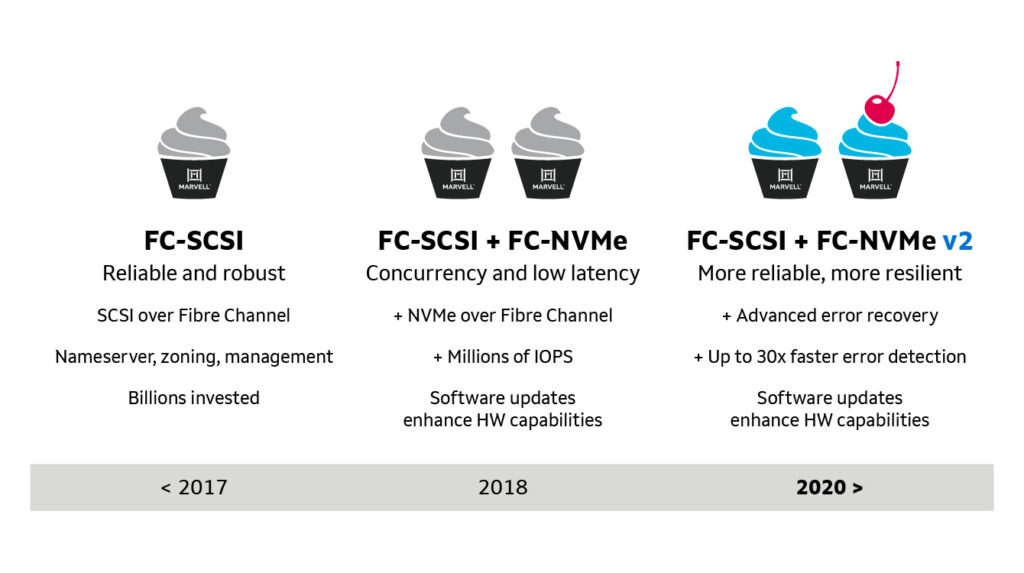- PRODUCTS
- COMPANY
- SUPPORT
- PRODUCTS
- BY TYPE
- BY MARKET
- COMPANY
- SUPPORT
Put a Cherry on Top! Introducing FC-NVMe v2
Once upon a time, data centers confronted a big problem – how to enable business-critical applications on servers to access distant storage with exceptional reliability. In response, the brightest storage minds invented Fibre Channel. Its ultra-reliability came from being implemented on a dedicated network and buffer-to-buffer credits. For a real-life parallel, think of a guaranteed parking spot at your destination, and knowing it’s there before you leave your driveway. That worked fairly well. But as technology evolved and storage changed from spinning media to flash memory with NVMe interfaces, the same bright minds developed FC-NVMe. This solution delivered a native NVMe storage transport without necessitating rip-and-replace by enabling existing 16GFC and 32GFC HBAs and switches to do FC-NVMe. Then came a better understanding of how cosmic rays affect high-speed networks, occasionally flipping a subset of bits, introducing errors.
Challenges in High-Speed Networks
But cosmic rays aren’t the only cause of bit errors. Soldering issues, vibrations due to heavy industrial equipment, as well as hardware and software bugs are all problematic, too. While engineers have responded with various protection mechanisms – ECC memories, shielding and FEC algorithms, among others – bit errors and lost frames still afflict all modern high-speed networks. In fact, the higher the speed of the network (e.g. 32GFC), the higher the probability of errors. Obviously, errors are never good; detecting them and re-transmitting lost frames slows down the network. But things get worse when the detection is left to the upper layers (SCSI or NVMe protocols) that must overcome their own quirks and sluggishness. Considering the low latency and high resiliency data center operators expect from FC-NVMe, these errors must be handled more efficiently, and much earlier in the process. In response, industry leaders like Marvell QLogic, along with other Fibre Channel leaders, came together to define FC-NVMe v2.
Introducing FC-NVMe v2
Intending to detect and recover from errors in a manner befitting a low-latency NVMe transport, FC-NVMe v2 (standardized by the T11 committee in August 2020) does not rely on the SCSI or NVMe layer error recovery. Rather, it automatically implements low-level error recovery mechanisms in the Fibre Channel’s link layer – solutions that work up to 30x faster than previous methods. These new and enhanced mechanisms include:
- FLUSH: A new FC-NVMe link service that can quickly determine if a sent frame does not quickly reach its destination. It works this way: if two seconds pass without the QLogic FC HBA getting a response back regarding a transmitted frame, it sends a FLUSH to the same destination (like sending a second car to the same parking spot, to see if is occupied). If the FLUSH gets to the destination, we know that the original frame went missing en route, and the stack does not need to wait the typical 60 seconds to detect a missing frame (hence the 30x faster).
- RED: Another new FC-NVMe link service, called Responder Error Detected (RED), essentially does the same lost frame detection but in the other direction. If a receiver knows it was supposed to get something but did not, it quickly sends out a RED rather than waiting on the slower, upper-layer protocols to detect the loss.
- NVMe_SR: Once either FLUSH or RED detects a lost frame, NVMe_SR (NVMe Retransmit) kicks in, and enables the re-transmission of whatever got lost the first time.
Complicated? Not at all -- these work in the background, automatically. FLUSH, RED, and NVMe_SR are the cherries on top of great underlying technology to deliver FC-NVMe v2!

Marvell QLogic FC HBAs with FC-NVMe v2
Marvel leads the T11 standards committee that defined the FC-NVMe v2 standard, and later this year will enable support for FC-NVMe v2 in QLogic 2690 Enhanced 16GFC and 2770 Enhanced 32GFC HBAs. Customers should expect a seamless transition from FC-NVMe v2 via a simple software upgrade, fulfilling our promise to avoid a disruptive rip-and-replace modernization of existing Fibre Channel infrastructure.
So, for your business-critical applications that rely on Fibre Channel infrastructure, go for Marvell QLogic FC-NVMe v2, and shake off the sluggish error recovery, and do more with Fibre Channel! Learn more at Marvell.com.
Tags: 16GFC, 32GFC, All flash array, FC-NVMe, FC-NVMe 2, Fibre Channel, NVMe, NVMe over Fibre Channel, NVMe over RoCE, NVMe over TCP, NVMe TCP, Sequence Level Error Recovery, server connectivity, SLER, storage connectivity
Recent Posts
- Marvell Wins LEAP Award for 1.6T LPO Optical Chipset
- Co-packaged Optics: Powering the Next Wave of AI Data Center Innovation
- AI Scale Up Goes for Distance with 9-meter 800G AEC from Infraeo and Marvell
- Faster, Farther and Going Optical: How PCIe Is Accelerating the AI Revolution
- Marvell Wins Leading EDGE Award for Ara 1.6T Optical DSP
Archives
Categories
- 5G (10)
- AI (42)
- Cloud (17)
- Coherent DSP (11)
- Company News (102)
- Custom Silicon Solutions (8)
- Data Center (65)
- Data Processing Units (21)
- Enterprise (24)
- ESG (10)
- Ethernet Adapters and Controllers (11)
- Ethernet PHYs (3)
- Ethernet Switching (41)
- Fibre Channel (10)
- Marvell Government Solutions (2)
- Networking (42)
- Optical Modules (18)
- Security (6)
- Server Connectivity (32)
- SSD Controllers (5)
- Storage (22)
- Storage Accelerators (2)
- What Makes Marvell (45)
Copyright © 2025 Marvell, All rights reserved.
- Terms of Use
- Privacy Policy
- Contact

